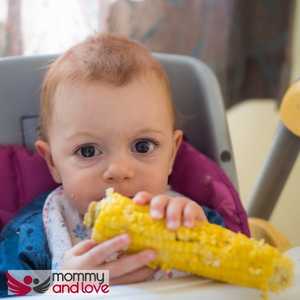Introducing sweet corn to your baby can be a fun and easy process when you do it through baby-led weaning. This method of introducing solid food allows your child to feed themselves, which helps them learn about food and develop their motor skills.
Sweet corn is a great new food to start with because it is soft, easy to chew, and has a mild flavor. In this blog post, we will discuss how to introduce corn to your baby using the baby-led weaning approach!
Is Corn Healthy for Babies?

Corn is a nutritious and healthy food for babies to eat. It is packed with essential vitamins and minerals that are necessary for a baby’s development.
Fiber
Cooked corn is a great source of insoluble fiber, which can help prevent constipation. Fiber is important for keeping the digestive system functioning properly. It also helps to keep babies feeling full and satisfied after eating.
Vitamin C
Vitamin C is important for a baby’s health and development. It helps the body absorb iron and is necessary for the formation of collagen, which is important for the growth and repair of tissues in the body. Vitamin C also helps to protect the body against infection.
Most babies get all the vitamin C they need from breast milk or infant formula. But certain foods such as corn are also an excellent source of vitamin C.
Potassium
Corn is also a good source of potassium. Potassium is important for the proper function of all cells, tissues, and organs in the body. It helps to regulate blood pressure and heart rate.
B Vitamins
Fresh sweet corn contains several B vitamins including thiamin, riboflavin, niacin, and folate. These vitamins are important for the proper function of the nervous system and for cell metabolism.
Folate is especially important for pregnant women because it helps to prevent certain birth defects.
Zinc
Corn is also a good source of zinc. Zinc is necessary for the proper growth and development of the body. It plays a role in the immune system, wound healing, and protein synthesis.
When Can Babies Eat Corn?

There are many ways to feed corn but before you let your baby eat corn make sure you understand the risks of giving whole grain kernels.
You can start feeding your baby corn at around six months old. If you are using the self-feeding approach, make sure to cut the corn cobs into small pieces that your baby can pick up and eat easily.
Don’t offer whole corn kernels if your baby is just starting. You can also offer whole sweet corn kernels as long as they are cooked until soft and your baby is old enough for them not to be choking hazards.
Babies can also have corn in the form of flour. Cornmeal or cornflour can be used to make pancakes, corn bread, biscuits, and other baby-friendly foods.
Corn meal or baby corn is a great way to start them on solid foods. It is easy to digest and has a high nutrient content. You can add it to breast milk or formula to make a thick gruel. It can also be mixed with water to make a thinner porridge. You can add fruit or vegetable purees to the baby corn for added nutrition and flavor. Just be sure to serve your baby properly cooked corn.
Is Corn a Choking Hazard for Babies?
Yes. Whole corn kernels can be a choking hazard for babies under the age of 12 months. Serve corn on the cob to lessen the risk because your baby’s gnawing and chewing skills will break the kernels, minimizing the choking risk.
Corn on the cob (not to be confused with field corn which is used to make corn flakes and corn syrup) is an excellent technique to encourage good dental development because biting on the cobs strengthens your child’s developing jaw muscles. Even so, keep an eye on your baby during mealtime. In theory, any food could be a choking hazard.
Is Corn a Common Allergen?
Corn allergies are not common, but they can cause an allergic reaction in some people. If you are concerned that your child may have a corn allergy, talk to your pediatrician or medical professional. They can perform a skin prick test or blood test to determine if your child is allergic to corn.
If you think your child may be having an allergic reaction to corn, seek medical attention immediately. Symptoms of an allergic reaction include hives, swelling, difficulty breathing, and dizziness.
Anaphylaxis is a severe and potentially life-threatening reaction that can occur with any allergen. If you think your child is having anaphylaxis, call 911 or take them to the nearest emergency room.
How to Prepare Corn on the Cob for Baby-led Weaning
If you’re looking for a fun and easy way to introduce your baby to solid foods, corn on the cob is a great option! It’s easy to prepare and can be served in a variety of ways. Plus, it’s a great source of nutrients like fiber and vitamins A and C.
When it comes to corn on the cob, there are a few things to keep in mind. First, it’s important to make sure to prepare corn properly and it is cooked all the way through. The corn kernels should be soft enough for your baby to gum or chew easily. Second, you’ll want to avoid adding any salt, sugar, or butter to the corn kernels. These ingredients can be harmful to babies and are unnecessary anyway since corn is naturally sweet and flavorful.
Here’s a simple recipe for preparing corn on the cob for baby-led weaning:
Ingredients:
- Corn on the cob (frozen corn)
- Water
- Steamer basket (optional)
Instructions:
- Safely prepare corn and fill a pot with enough water to cover the bottom of the steamer basket. If you don’t have a steamer basket, just fill the pot with enough water to reach the top of the corn.
- Place the corn in the steamer basket or directly in the pot of boiling water. Cover and bring to a boil.
- Reduce the heat and simmer for about five minutes, or until the corn is cooked through.
- Carefully remove the corn from the pot and let it cool before serving. You can also cut the kernels off of the cob if you prefer. Serve with a little bit of water on the side for dipping.
There are other corn recipes out there so pick one which you think is best for your child.
What other foods can you pair corn with for baby-led weaning?
You can serve corn with carrots. You can either steam them or roast them in the oven. Other vegetables include green beans (see our guide to blw beans here). These can also be steamed or roasted. Puréed corn with thin consistency also pairs well with mashed potatoes.
If you want to give your baby something sweet, fruit is always a good choice. Peaches (guide to blw peaches), apricots, and plums go well with corn. You can also pair corn with yogurt or cottage cheese. Cheese and cob also go well.
Baby-led weaning is all about giving your baby’s diet a variety of different foods to try. So don’t be afraid to experiment! There are no hard and fast rules. Just have fun and see what your little one enjoys.
Conclusion
Corn is a great finger food to introduce to your baby through baby-led weaning. It’s easy to prepare and can be served in a variety of ways. Plus, it’s a great source of nutrients like fiber and vitamins A and C which are good for your baby’s growth. Just be sure to cook the corn all the way through so that it is soft enough for your baby to gum or chew easily. And avoid adding any salt, sugar, or butter to the corn. These ingredients can be harmful to babies and are unnecessary anyway since corn is naturally sweet and flavorful. Baby-led weaning is all about giving your baby a variety of different foods to try. So don’t be afraid to experiment!

This article was written by Sandra Baker – full time writer and the mother of four amazing kids (including twins!)
She’s also a breastfeeding counselor and has spent years helping new parents learn how to care for their children. When she’s not writing or caring for her children, Sandra likes to spend time reading and taking walks with her husband.




